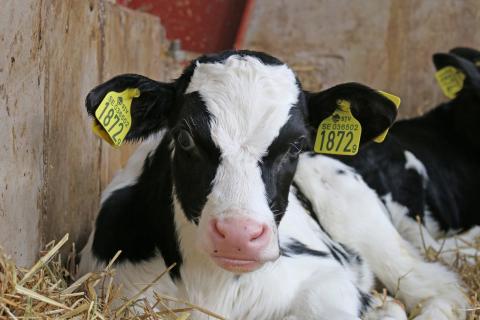Knock, Knock. Moos There?

Written by Kayla Aragona, B.S., M.S., Ph.D. Student, University of New Hampshire
In the US, 5.6% of calves are stillborn, with a higher rate (6.8%) reported on farms with 100 cows (NAHMS, 2014). The NAHMS report indicates a decline in stillborn loss, down from to 8.1% in 2007. A major contributor to stillborn births is a difficult calving, or dystocia. Other contributing causes include congenital, infectious, nutritional and management factors. Dystocia can potentially lead to the loss of both dam and calf, but can also have adverse effects on the health and productivity of both dam and newborn calf as well.
Severe dystocia in the dam may negatively impact production and conception rates, and increase risk of being culled from the herd (Tenhagen et al., 2007). Heifer calves born to dams having dystocia had an increased risk of respiratory disease, digestive disease and overall mortality up to 30 d of age (Lombard et al., 2007). Calves that experience dystocia exhibit hypoxia and acidosis, both of which can negatively impact the absorption of essential colostral immunoglobulins (Besser et al., 1990). Research indicates that heifer calves that do not absorb proper amounts of immunoglobulins in the first 24 h of life have increased risk of morbidity and mortality, decreased growth rates and decreased milk production in the first and second lactations (Robison et al., 1998; DeNise et al., 1989).
After a dairy farmer in Ireland lost a cow and her calf during an unattended calving, Moocall was developed. The noninvasive sensor attaches to the tail head of the cow, up against the vulva. The sensor measures tail movement triggered by labor contractions and is capable of gathering more than 600 pieces of data per second. A text is sent to a cell phone once a cow reaches a specific level of intensity and movement. Typically, this gives notice to the farmer an hour prior to calving. Not only can Moocall help to reduce stillbirths, it will also allow the farmer to sleep more comfortably knowing his cow will text him when she is ready to calve.
Thus far, the Moocall has been very reliable at accurately predicting when my cows will calve. Not only has it saved me hours of sleep, but in my opinion, it has also saved the lives of a few of the calves. The Moocall gives me plenty of notice to arrive at the barn during the calving process, allowing me the time to observe and decide if a cow requires my assistance. Typically, cows at the Fairchild Dairy Center calve quite easily on their own, but on a few occasions, I did intervene when I thought it was necessary; the calves from these births ended up weighing 120+ pounds and clearly would not have been delivered successfully without my intervention. It is suggested that one Moocall is sufficient for a 50 cow herd with year round calving. A farmer can purchase a Moocall online for about $299.
Sources:
Besser,T.E., O. Szenci, C.C. Gay. 1990. Decreased colostral immunoglobulin absorption in calves with postnatal respiratory acidosis. J. Am. Vet. Med. Assoc. 196:1239–1243.
DeNise, S.K., J.D. Robison, G.H. Stott and D.V. Armstrong. 1989. Effects of passive immunity on subsequent production in dairy heifers. J. Dairy Sci. 72:552-554.
Lombard J.E., F.B. Garry, S.M. Tomlinson, and L.P. Garber. 2007. Impacts of dystocia on health and survival of dairy calves. J. Dairy Sci 90:1751-1760.
NAHMS. 2014. Dairy cattle management practices in the United States. Accessed Aug 16, 2016
Robison, J.D., G.H. Stott and S.K. DeNise. 1988. Effects of passive immunity on growth and survival of the dairy heifer. J. Dairy Sci. 71:1283-1287.
Tenhagen BA, Helmbold A, Heuwiser W. 2007. Effects of various degrees of dystocia in dairy cattle on calf viability, milk production, fertility and culling. J Vet Med A Physiol Pathol Clin Med 54:98-102.

